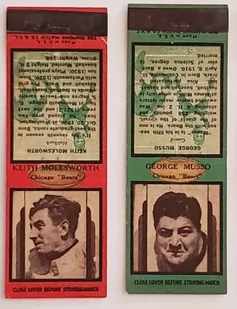1984 Topps FB #111 Howie Long ROOKIE
| Grade |
NM/MINT |
| Book Value |
$ 20 |
| Our Price |
$ 24.95
Add to cart
|


Below are short bits & pieces on sportscard & baseball trading card collecting.
Please wander around the website for more info, prices, values & images
on vintage baseball, football, basketball, hockey, sport and non-sports cards.
1954 Bowman Baseball
Cards Checklist & Values
Competition was raging between Topps and Bowman in 1953 and 1954 leading to
problems with both companies sets. Bowman caused Topps to missing 6 cards
in 1953 with Topps getting revenge by signing Ted Williams to an exclusive
contract in 1954. Bowman then had to pull Ted Williams card #66 from their
set shortly after they started printing, replacing it with Jimmy Piersall,
who also was on card #210 making the 1954 Bowman Ted Williams #6
one of 50's scarcest cards.
 Perhaps distracted by it's competition with Topps, the 1954 Bowman set was
filled with errors and variations. Nearly 20% (40/224 cards) had some sort
of variation, with some having more than 2.
Perhaps distracted by it's competition with Topps, the 1954 Bowman set was
filled with errors and variations. Nearly 20% (40/224 cards) had some sort
of variation, with some having more than 2.
The St. Louis Browns recent move to Baltimore also made things interesting.
Bowman's artists had no idea what an Orioles jersey would look like -
so they just madeone up.
 TOP ROOKIES: Don Larsen, Harvey Kuenn, Frank Thomas
TOP ROOKIES: Don Larsen, Harvey Kuenn, Frank Thomas
TOP STARS: Mickey Mantle, Willie Mays, Yogi Berra, Duke Snider,
Roy Campanella, Whitey Ford, Phil Rizzuto ...
Ted Williams is not considered part of a complete set.
Click for complete
1954 Bowman Baseball card checklist, values and prices.
Note: You may be on that page right now.
|



|
1955 / 1959 / 1960 Armour Hot Dog Coins
Checklist & Values

As a kid I loved shopping with mom hoping to find my next favorite
food - the one with baseball cards !!!
In 1955,1959 & 1960, kids could enjoy hot dogs with their cards
thanks to Armour's coins in 1955, 1959 & 1960.
The 1-1/2 inch plastic coins, almost the same each year, came in
many colors with several rare and perhaps even 1-of-1,
making a "master" set almost impossible.
Add in the variations and you can imagine the task.
See sportscollectorsdaily for great 1955,1959 & 1960 Armour baseball
coins article.
Click for complete
1955/1959/1960 Armour Baseball Coins
Checklist & Values
|

1934,1935,1936,1937 Diamond
Football Matchbooks

Matchbook collecting was sweeping the nation back in the 1930's
with most sports matchbooks issued by Diamond Match Company out
of New York.
The football matchbooks were printed over a period of several
years in assortment of colors and included both professional and
collegiate football players.
1930's matchbooks are huge bargains for collectors as their
values are fractions of that of Goudey and other issues from the 1930's.
Diamond also produced several issues of Hockey and Baseball Matchbooks.
Click for complete
1935-1936 Diamond Baseball Matchbook Checklist and Prices
Click for complete
1934-1938 Diamond Football Matchbook Checklist and Prices
Note: You may be on that page right now.
|

Tobacco Cards
Starting approximately in 1886, sportscards, mostly baseball cards, were often
included with tobacco products, for promotional purposes and also because the
card reinforced the packaging and protected cigarettes from damage. These sports
cards are referred to as tobacco cards in the baseball card hobby. Over the next
few years many different companies produced baseball cards. Tobacco cards soon
started to disappear as the American Tobacco Company tried to develop a monopoly
by buying out other companies.
They were reintroduced in the 1900s, as American Tobacco came under pressure from
antitrust action and Turkish competition. The most famous and most expensive,
baseball card is the rare T206 Honus Wagner. The card exists in very limited
quantities compared to others of its type because Wagner forced the card to be
removed from printing. It is widely (and incorrectly) believed that Wagner did
so because he refused to promote tobacco, but the true explanation lies in a
dispute over compensation.
Soon other companies also began producing baseball and football cards. Sports magazines
such as The Sporting News were early entries to the market. Candy manufacturers
soon joined the fray and reflected a shift toward a younger target audience for cards.
Caramel companies were particularly active and baseball cards were one of the first
prizes to be included in Cracker Jacks. World War I soon suppressed baseball card
production.







 Perhaps distracted by it's competition with Topps, the 1954 Bowman set was
filled with errors and variations. Nearly 20% (40/224 cards) had some sort
of variation, with some having more than 2.
Perhaps distracted by it's competition with Topps, the 1954 Bowman set was
filled with errors and variations. Nearly 20% (40/224 cards) had some sort
of variation, with some having more than 2.  TOP ROOKIES: Don Larsen, Harvey Kuenn, Frank Thomas
TOP ROOKIES: Don Larsen, Harvey Kuenn, Frank Thomas 

